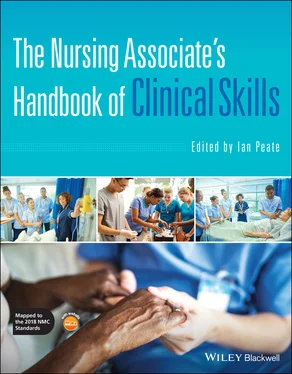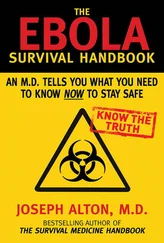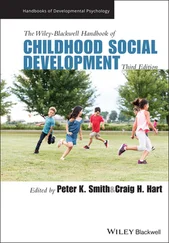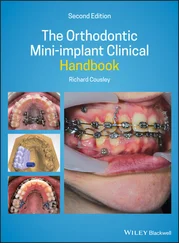The Nursing Associate's Handbook of Clinical Skills
Здесь есть возможность читать онлайн «The Nursing Associate's Handbook of Clinical Skills» — ознакомительный отрывок электронной книги совершенно бесплатно, а после прочтения отрывка купить полную версию. В некоторых случаях можно слушать аудио, скачать через торрент в формате fb2 и присутствует краткое содержание. Жанр: unrecognised, на английском языке. Описание произведения, (предисловие) а так же отзывы посетителей доступны на портале библиотеки ЛибКат.
- Название:The Nursing Associate's Handbook of Clinical Skills
- Автор:
- Жанр:
- Год:неизвестен
- ISBN:нет данных
- Рейтинг книги:4 / 5. Голосов: 1
-
Избранное:Добавить в избранное
- Отзывы:
-
Ваша оценка:
- 80
- 1
- 2
- 3
- 4
- 5
The Nursing Associate's Handbook of Clinical Skills: краткое содержание, описание и аннотация
Предлагаем к чтению аннотацию, описание, краткое содержание или предисловие (зависит от того, что написал сам автор книги «The Nursing Associate's Handbook of Clinical Skills»). Если вы не нашли необходимую информацию о книге — напишите в комментариях, мы постараемся отыскать её.
The Nursing Associate’s Handbook of Clinical Skills
The Nursing Associate’s Handbook of Clinical Skills
The Nursing Associate's Handbook of Clinical Skills — читать онлайн ознакомительный отрывок
Ниже представлен текст книги, разбитый по страницам. Система сохранения места последней прочитанной страницы, позволяет с удобством читать онлайн бесплатно книгу «The Nursing Associate's Handbook of Clinical Skills», без необходимости каждый раз заново искать на чём Вы остановились. Поставьте закладку, и сможете в любой момент перейти на страницу, на которой закончили чтение.
Интервал:
Закладка:
About the Editor

Ian Peate OBE FRCN Principal, School of Health Studies, Gibraltar
Visiting Professor of Nursing at St George’s University of London and Kingston University, London; Visiting Professor at Northumbria University; Visiting Senior Clinical Fellow at the University of Hertfordshire; Head of School, School of Health Studies, Gibraltar; and Editor in Chief of the British Journal of Nursing .
Ian began his nursing career at Central Middlesex Hospital, becoming an enrolled nurse practising in an intensive care unit. He later undertook 3 years’ student nurse training at Central Middlesex and Northwick Park Hospitals, becoming a staff nurse and then a charge nurse. He has worked in nurse education since 1989. Ian’s key areas of interest are nursing practice and theory, and he has published widely. He was awarded an OBE in the Queen’s 90th Birthday Honours List for his services to Nursing and Nurse Education, and was bestowed a Fellowship from the Royal College of Nursing in 2017.
About the Companion Website
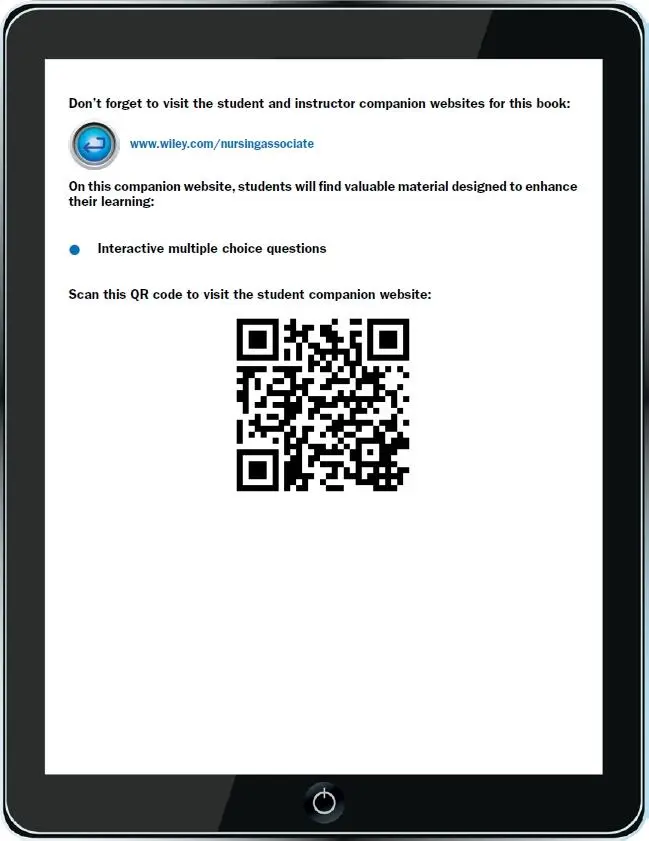
1 Theories and Models of Communication
Janine Archer and Lesley Jones
University of Salford, UK
Chapter Aim
To explore the theories and models that underpin communication relevant to the role of a nursing associate
Learning Outcomes
By the end of this chapter, the reader will be able to:
Identify and define the components of the three models of communication
Describe contextual factors that affect communication
Understand the importance of effective communication within the role of a nursing associate
Test Yourself Multiple Choice Questions
1 What are the three key communication models?Transgression, interaction and transactionTransmission, interaction and transactionTransport, interaction and transactionTransmission, intervention and transaction
2 Which of the following is/are the result(s) of poor communication?Medication errorPoor patient outcomesLow staff moraleAll of the above
3 Which of the following terms is used to describe a communication barrier?ChannelCodeNoiseReceiver
4 Which of the following represents the contexts considered important in the Transactional Model of Communication?Psychological, social, cultural and relationalPhysical, psychological, social and culturalPhysical, psychological, social, cultural and relationalPhysical, social, cultural and relational
5 In Peplau’s interpersonal relations theory, which of the following indicates when the nurse and patient begin to work collaboratively to enable the patient to become an active recipient of treatment?Orientation phaseIdentification phaseExploitation phaseResolution phase
Introduction
Nursing associates provide safe and effective holistic patient‐centred care that is underpinned by the 6Cs of caring (Department of Health 2012). Communication, one of the 6Cs, is a complex yet critical element in all areas of nursing activity. The nursing process, the assessment, diagnosing, planning, implementation and evaluation of care, is achieved only through careful attention to interpersonal relationships, the environment and the specific skills of verbal and non‐verbal communication. Nursing associates are required to communicate with a wide variety of patients across their lifespan, including babies, children and young people, carers and families, and adults and older people. They are expected to provide prevention, treatment, rehabilitation and end‐of‐life care while working in a broad range of settings, such as at home, close to home and in hospital. They do not work in isolation and so require excellent communication skills to work effectively with not just patients and carers but also health and social care colleagues within a multidisciplinary team. Many of the people nursing associates communicate with will have communication challenges requiring them to make reasonable adjustments and adapt their style of communication.
There is a well‐established link between team communication, worker morale and patient safety. Poor team communication has been directly linked to high nurse turnover rates and low morale (Brinkert 2010). Low morale contributes to high levels of stress, burnout, poor job satisfaction and an overall poor quality of life (Khamisa et al. 2015).
Supporting Evidence
The National Institute for Health and Care Excellence (2016) has provided guidance for health and social care professionals to enhance the transition between inpatient mental health settings and community or care home settings
https://www.nice.org.uk/guidance/ng53/resources/tailored‐resources‐4429245855/chapter/2‐Ensuring‐effective‐communication‐between‐teams‐and‐with‐people‐using‐services‐families‐and‐carers
Poor communication is often a feature in healthcare related events (Burgener 2017) with communication issues frequently featuring in National Health Service (NHS) complaints and medication related events. Within hospital and community health services, Ombudsman data identifies communication issues as one of the five most common complaint factors in cases which were fully or partially upheld in 2018–19 (Parliamentary and Health Service Ombudsman 2019).
In recent years, a number of serious failings in healthcare provision have made national news, for example, the Francis enquiry. This public enquiry reviewed reports on poor care in the Mid Staffordshire Foundation NHS Trust between 2005 and 2009, which was believed to have contributed to the avoidable death of many patients and highlighted communication failings in sharing information and concerns (Francis 2013).
Poor communication between healthcare professionals, poor communication with patients and limited communication between primary and secondary care have all been identified as factors which influence medication errors (World Health Organization 2016). Keers et al. (2013), in a systematic review of causes of medication administration errors in hospital, also identified inadequate written communication as a factor.
Take Note
 Ineffective communication among healthcare professionals is one of the leading causes of error and patient harm, as well as reducing staff morale
Ineffective communication among healthcare professionals is one of the leading causes of error and patient harm, as well as reducing staff morale
Good communication is essential in meeting patients’ needs and providing safe, quality patient care. Improvements in communication can lessen healthcare errors and make a positive impact on patient outcomes. For the nursing associate, it is important that they develop underpinning knowledge about communication as well as the skills to deliver effective communication to provide high quality care.
Red Flag
 Poor communication between nursing associates and those they offer care and support to can occur for a variety of reasons. The provision of health and social care can be very unpredictable, complicated and stressful. The needs of patients can arise unexpectedly, and their condition can change very rapidly; when there is a communication breakdown, this can lead to negative care outcomes.
Poor communication between nursing associates and those they offer care and support to can occur for a variety of reasons. The provision of health and social care can be very unpredictable, complicated and stressful. The needs of patients can arise unexpectedly, and their condition can change very rapidly; when there is a communication breakdown, this can lead to negative care outcomes.
Интервал:
Закладка:
Похожие книги на «The Nursing Associate's Handbook of Clinical Skills»
Представляем Вашему вниманию похожие книги на «The Nursing Associate's Handbook of Clinical Skills» списком для выбора. Мы отобрали схожую по названию и смыслу литературу в надежде предоставить читателям больше вариантов отыскать новые, интересные, ещё непрочитанные произведения.
Обсуждение, отзывы о книге «The Nursing Associate's Handbook of Clinical Skills» и просто собственные мнения читателей. Оставьте ваши комментарии, напишите, что Вы думаете о произведении, его смысле или главных героях. Укажите что конкретно понравилось, а что нет, и почему Вы так считаете.
